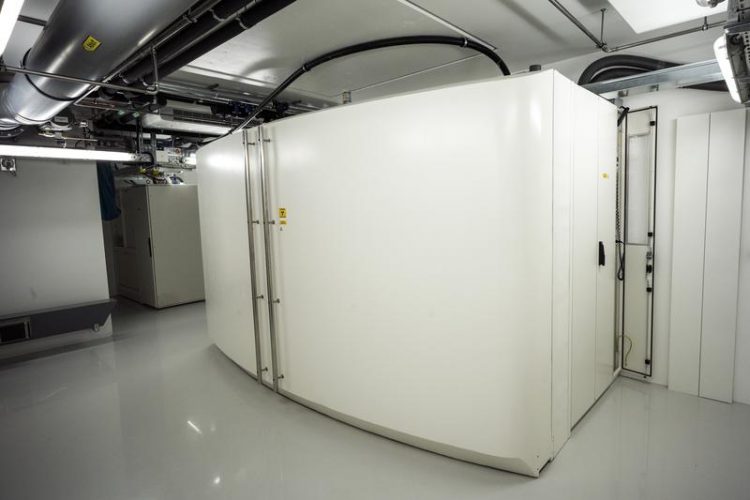Cyclotron opens up new prospects for fundamental & applied research in radiopharmaceutical chemistry

PETtrace 700S cyclotron with closed radiation shield photo/©: Stefan F. Sämmer, JGU
A new particle accelerator is further enhancing the research landscape at Johannes Gutenberg University Mainz (JGU). It is to be employed to conduct research into potential applications of medical relevance.
The cyclotron was installed in a basement building at the JGU Institute of Nuclear Chemistry in December 2015 and has now been officially put into operation. It will be used to generate isotopes with a short half-life, which are important for fundamental research but are also required for the medical imaging technique known as positron emission tomography (PET). The German Research Foundation (DFG) and the Rhineland-Palatinate Research Initiative funded this research facility worth some EUR 1 million.
The JGU cyclotron is a ring-shaped particle accelerator that occupies an approximate floor space of 7.5 square meters and has a height of some two meters. The accelerator weighs about 50 tonnes and when it was installed in December 2015, a crane had to be used to lower it through a hole in the ceiling into the basement room.
Mainz University constructed this new building complex at a cost of around EUR 1.2 million. It is accommodating the cyclotron and includes other facilities containing technical and control equipment plus an air lock. The structure is linked directly to the extension building of the Institute of Nuclear Chemistry and has all safety-relevant features.
As it is able to accelerate protons to an energy of 9.6 mega electron volts (MeV), the cyclotron can be used to generate the two radioactive elements fluorine-18 and carbon-11. These will be mainly employed for chemical and pharmaceutical research purposes but are also required for the PET medical diagnostic imaging technique. F-18 and C-11 have short half-lives of just two hours and 20 minutes, respectively, which makes it necessary to generate them near the location at which they are to be used to ensure that they are available in sufficient quantities. The launch of the new cyclotron means is it now possible to produce C-11-labelled radiopharmaceuticals on site in Mainz.
“The cyclotron supplements the research infrastructure already in place at Mainz University. Now that we can produce our own radioactive nuclides, we have additional opportunities for our research and development of alternative radiopharmaceuticals,” explained Professor Frank Rösch of the JGU Institute of Nuclear Chemistry. “It will significantly facilitate the generation of new radiopharmaceuticals and their preclinical evaluation as well as—working in collaboration with the Department of Nuclear Medicine at the Mainz University Medical Center—potential applications in human medicine.”
Additional benefits are to be expected through interdisciplinary joint projects in which the disciplines of nuclear chemistry, pharmacy, organic chemistry, and nuclear medicine at JGU will collaborate with regard to the development and evaluation of new PET radiopharmaceuticals with external institutions, such as the Department of Psychiatry, Psychotherapy and Psychosomatics at RWTH Aachen University and Max Planck Institute for Polymer Research in Mainz.
Photos:
http://www.uni-mainz.de/presse/09_kernchemie_zyklotron1.jpg
PETtrace 700S cyclotron with closed radiation shield
photo/©: Stefan F. Sämmer, JGU
http://www.uni-mainz.de/presse/09_kernchemie_zyklotron2.jpg
The cyclotron with open radiation shield showing a view on the targets (left), the magnets and the cyclotron itself (center), and the vacuum system (right)
photo/©: Stefan F. Sämmer, JGU
Further information:
Professor Dr. Frank Rösch
Institute of Nuclear Chemistry
Johannes Gutenberg University Mainz (JGU)
55099 Mainz, GERMANY
phone +49 6131 39-25302
fax +49 6131 39-24692
e-mail: frank.roesch@uni-mainz.de
http://www.kernchemie.uni-mainz.de/radiopharmazie-roesch/127_ENG_HTML.php
Related links:
http://www.kernchemie.uni-mainz.de/eng/index.php – Institute of Nuclear Chemistry at JGU ;
http://www.kernchemie.uni-mainz.de/radiopharmazie-roesch/117_ENG_HTML.php – Working group Radiopharmaceutical Chemistry at the JGU Institute of Nuclear Chemistry
http://www.uni-mainz.de/presse/20010_ENG_HTML.php – press release “Mainz University installs a new particle accelerator to be used for fundamental research into radiopharmaceutical chemistry”, 5 January 2016 ;
http://www.uni-mainz.de/presse/19663_ENG_HTML.php – press release “German Research Foundation, Rhineland-Palatinate, and Mainz University invest more than EUR 2 million in a cyclotron and its building complex”, 19 October 2015
Media Contact
All latest news from the category: Life Sciences and Chemistry
Articles and reports from the Life Sciences and chemistry area deal with applied and basic research into modern biology, chemistry and human medicine.
Valuable information can be found on a range of life sciences fields including bacteriology, biochemistry, bionics, bioinformatics, biophysics, biotechnology, genetics, geobotany, human biology, marine biology, microbiology, molecular biology, cellular biology, zoology, bioinorganic chemistry, microchemistry and environmental chemistry.
Newest articles

First-of-its-kind study uses remote sensing to monitor plastic debris in rivers and lakes
Remote sensing creates a cost-effective solution to monitoring plastic pollution. A first-of-its-kind study from researchers at the University of Minnesota Twin Cities shows how remote sensing can help monitor and…

Laser-based artificial neuron mimics nerve cell functions at lightning speed
With a processing speed a billion times faster than nature, chip-based laser neuron could help advance AI tasks such as pattern recognition and sequence prediction. Researchers have developed a laser-based…

Optimising the processing of plastic waste
Just one look in the yellow bin reveals a colourful jumble of different types of plastic. However, the purer and more uniform plastic waste is, the easier it is to…



